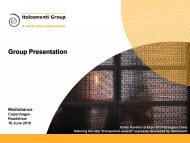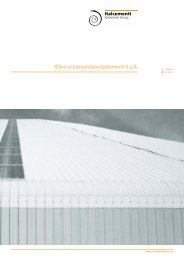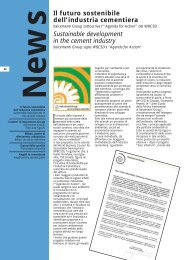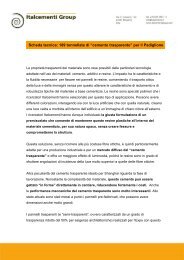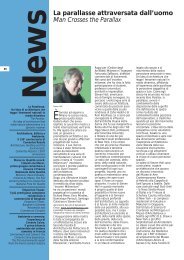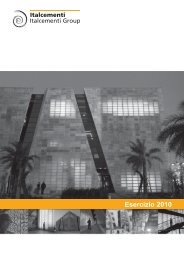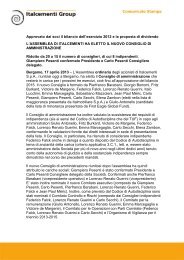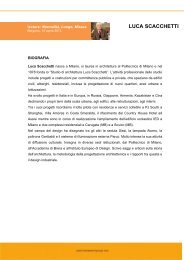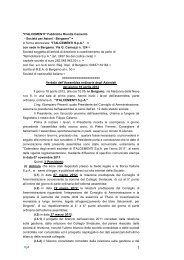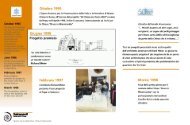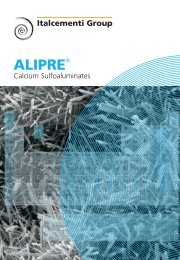2012 Annual Report - Italcementi Group
2012 Annual Report - Italcementi Group
2012 Annual Report - Italcementi Group
Create successful ePaper yourself
Turn your PDF publications into a flip-book with our unique Google optimized e-Paper software.
<strong>2012</strong> <strong>Annual</strong> <strong>Report</strong><br />
Presentation 4<br />
General information 14<br />
<strong>Annual</strong> <strong>Report</strong> Consolidated <strong>Annual</strong> <strong>Report</strong> Directors’ report 30<br />
Sustainability disclosure <strong>Italcementi</strong> S.p.A. <strong>Annual</strong> <strong>Report</strong> Consolidated financial statements 63<br />
Extraordinary session 351<br />
Notes<br />
The consolidated financial statements of <strong>Italcementi</strong> S.p.A. as at and for the year ended December 31, <strong>2012</strong><br />
were approved by the Board of Directors on March 5, 2013. At the meeting the Board authorized publication of<br />
a press release dated March 5, 2013 containing key information from the financial statements.<br />
<strong>Italcementi</strong> S.p.A. is a legal entity established in accordance with the laws of the Republic of Italy. It has been<br />
listed on the Stock Exchange since 1925 and is subject to management and coordination by Italmobiliare<br />
S.p.A., whose key data from the most recently approved financial statements are provided in an annex to the<br />
separate financial statements.<br />
<strong>Italcementi</strong> S.p.A. and its subsidiaries form the “<strong>Italcementi</strong> <strong>Group</strong>”, an international player whose main lines of<br />
business are hydraulic binders, ready mixed concrete and aggregates. The <strong>Group</strong> is also active in other areas,<br />
some of which are instrumental to its core businesses: materials for the construction industry, transport,<br />
energy, engineering and e-business.<br />
The financial statements have been drawn up on a going-concern basis. Despite the difficult economic and<br />
financial situation, by virtue of the measures already in place to respond to the changes in demand, and its<br />
business and financial flexibility the <strong>Group</strong> has no material uncertainties about its ability to continue as a going<br />
concern.<br />
With the completion of the standardization of the chart of accounts among the <strong>Group</strong> companies, a number of<br />
reclassifications were necessary for an immaterial combined amount with respect to the figures in the<br />
consolidated financial statements at December 31, 2011; they related to trade payables and other current<br />
liabilities.<br />
1. Accounting policies<br />
1.1. Statement of compliance with the IFRS<br />
These consolidated financial statements have been drawn up in compliance with the International Financial<br />
<strong>Report</strong>ing Standards (IFRS) applicable at December 31, <strong>2012</strong> endorsed by the EC Commission.<br />
In compliance with European Regulation no. 1606 of July 19, 2002, the policies adopted do not include the<br />
standards and interpretations published by the IASB and the IFRIC through December 31, <strong>2012</strong> that had not<br />
been endorsed by the European Union at that date.<br />
With respect to December 31, 2011, the amendment to IFRS 7 “Financial instruments: disclosures”<br />
relating to disclosures to be made on the transfer of financial assets came into force in <strong>2012</strong>; it did not have a<br />
material impact.<br />
At December 31, <strong>2012</strong>, the European Union endorsed the following standards and interpretations which have<br />
not yet come into force, for which early application has not been elected:<br />
Standards and interpretations to come into force in 2013<br />
Amendments to IAS 1 “Presentation of financial statements” relating to the presentation of other<br />
comprehensive income.<br />
Amendments to IAS 19 “Employee benefits”. The main changes refer to treatment of past service costs that<br />
have not vested and the actuarial gains/losses to be immediately recognized respectively in profit/loss for<br />
the period and in other comprehensive income (elimination of the corridor method), the adoption, for plan<br />
assets, of the discount rate used to determine the defined benefit liability.<br />
Amendments to IFRS 7 “Financial instruments: disclosures” regarding offsetting of financial assets and<br />
liabilities.<br />
Amendments to IFRS 1 “First-time adoption of IFRS” regarding severe hyperinflation and removal of fixed<br />
dates for first-time adopters.<br />
71<br />
www.italcementigroup.com



